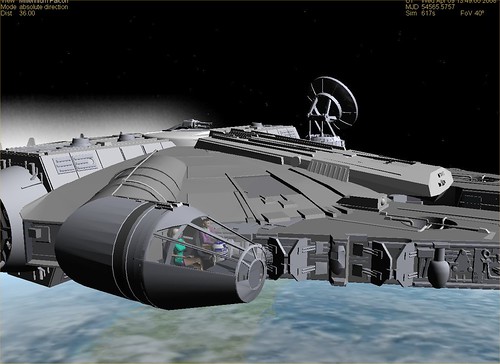 I am re-reading two wonderful books by the late Octavia Butler, The Parable of the Sower (just finished) and The Parable of the Talents (just started). Here's my discussion from 2006. On re-reading these books, I am again struck by how viscerally real and plausible this terrifying future seems. I hope this isn't where we are heading, but it could be.
I am re-reading two wonderful books by the late Octavia Butler, The Parable of the Sower (just finished) and The Parable of the Talents (just started). Here's my discussion from 2006. On re-reading these books, I am again struck by how viscerally real and plausible this terrifying future seems. I hope this isn't where we are heading, but it could be.I’ve just finished two fine science fiction novels by Octavia E. Butler,
The Parable of the Sower and
The Parable of the Talents. Amazon somehow suggested them, and they did not seem at first to be the type of SF that I usually enjoy (I’m generally more of a “hard SF” fan). While I have read and enjoyed a number of SF novels of the near future post-apocalyptic genre, these books seemed to have a religious, cultural, and feminist orientation that I was not sure I would enjoy. But as it turns out,
Butler was an amazing writer, there was more than enough realism, and even the religious aspects of the story touched me in unexpected ways. She brought me into a world that was in many ways uncomfortable to visit (largely because it seemed so plausible), and took me on a journey that was precarious, unexpected, thought-provoking, and ultimately rewarding.
The Destiny of Earthseed
Is to take root among the stars.
-EARTHSEED: THE BOOKS OF THE LIVING by Lauren Oya Olamina
The quote above is taken from a fictional work of inspirational poetry by the main character of the two
Parable books, Lauren Oya Olamina (Butler wrote the quoted passages from this fictional work, some of which are collected
here) . She starts out as a 16 year old African-American girl in suburban Los Angeles circa 2027. Global warming and other severe problems have led to a near-total breakdown in American society, and she and her family live in a walled neighborhood surrounded by poverty and chaos. Her neighborhood is finally destroyed and most of her family and neighbors are killed, but Lauren manages to escape and to make her way to northern California. Along the way she helps, is helped by, and starts to gather a group of people with whom she later builds a small, self-sufficient community called Acorn.
There are a number of special things about Lauren, but what is most notable is that since age 12, she has been thinking and writing about certain “truths” that she sees about the universe, about people and their problems and relationships, and about what the ultimate purpose or destiny of humanity might be. Through her writings and eventual teaching, she establishes a community-oriented, humanistic religion called Earthseed, with the central message “God is change” (her God is not a conscious entity, but more of an organizing principle) and the idea that humankind is truly “Earthseed” whose destiny is to take root among the stars. There is a long and torturous route to that destiny, and Lauren and her ideas are very nearly destroyed by "good Christian" citizens of an America that has descended into chaos, and whose leaders have allowed radical fundamental Christians to take over the agenda of what is left of the nation, forming what is essentially a Christian theocracy which bears more than a small resemblance to Taliban Afghanistan.
I won’t go into many more details here (see the excellent reviews of
Sower and
Talents by Russ Allbery for more discussion of the books). My biggest impression of this pair of books is that the environment within which the story takes place rings all too true. It struck me as the future “facts on the ground” of an America that continued to ignore “inconvenient truths” of global warming, poverty, inequality, and abuse of power until it was too late, and then gave even more power to religious fundamentalists, who blamed the problems of society on the victims, and on superstitious ideas along the lines of “these problems are God’s punishment for the wicked ways of people who are not enough like us – good, God-fearing, white, conservative Christians.”
In contrast, the teachings of Earthseed are inclusive, community-oriented, and flexible, with a text that offers inspiration and a base of shared ideas, some simple rituals that provide structure and are eventually comforting to members of the community, and which even provides a “destiny,” a long term and not immediately obvious goal – the idea of spreading humanity beyond the solar system, to colonize planets of other stars. This is the part that first appealed to me – and the fact that it was treated as a religious goal and not merely as a technological or economic goal was interesting and perhaps almost necessary. Maybe there is a little bit of “heaven” in the ideas of people (like me) who seek to send humans into space, to colonize Mars and other places in the solar system, and eventually to go beyond, to the stars. I don’t believe in any sort of immaterial soul or afterlife or in any sort of god who listens to and cares about people. I believe that as far as intelligence and purpose here on Earth, humanity is all there is (while not ruling out intelligent life elsewhere in the universe).
But humanity and its civilization are enough, and we are well worth preserving, here and elsewhere, with the “elsewhere” part forming a sort of space-based backup plan. I don’t think it’s actually “destiny” but it is in our genes and in our culture, a logical extension of the part of us that says “take care of the children, they are your future.” That is the route to immortality – when we send our ideas and our children into the future, a little bit of each of us will survive too. Like Earthseed.
 I worry too much about having enough reading material for trips. I even installed a book reader (Mobipocket) and a few "emergency" books on my Blackberry for spare time tiny-screen reading (of course there's plenty of reading material on my notebook too).
I worry too much about having enough reading material for trips. I even installed a book reader (Mobipocket) and a few "emergency" books on my Blackberry for spare time tiny-screen reading (of course there's plenty of reading material on my notebook too).




































